Electricity and Magnetism
Magnetism, Electromagnetism, and Electric Motors
MINDS ON
Magnetism and electromagnetism are closely interlinked phenomena that can be used to create useful machines, as well as fascinating effects.

These two phenomena are used for purposes such as audio recording and reproduction, electric car propulsion, as well as facilitating the efficient transmission of energy using the electrical grid.
 Reflection
Reflection
Create a reflection to answer the following questions:
- Brainstorm to record a list of objects or devices you use on a daily basis that incorporate magnets and/or electromagnets.
- Imagine how your life would be different without those objects or devices.
- Both magnetism and electromagnetism can provide a means for objects to interact at a distance, and without a mechanical connection, such as a string or rod. Can you think of any other phenomena that can act without a mechanical connection?
ACTION

Most people are familiar with magnets. They may have experimented with magnets and experienced the poles of the magnets either attracting or repelling each other, or attracting other objects nearby. They may have observed a compass needle somehow always pointing north. They may have used a magnet to attach a note to the fridge. While experience with magnets is very common, most people do not have any understanding of the physics that results in the phenomenon we observe as magnetism.
Magnets have two poles, north and south. The north pole of a magnet is the one that will be attracted to the Earth’s magnetic pole in the northern hemisphere. The south pole of a magnet is the one that will be attracted to the Earth’s magnetic pole in the southern hemisphere. While the Earth’s magnetic pole in the northern hemisphere is sometimes referred to (particularly by Geographers) as the Earth’s north magnetic pole, it is actually a south pole which attracts the north pole of a magnet. An analogous situation exists in the southern hemisphere.
Law of Magnetic Poles
The law of magnetic poles states that like magnetic poles repel each other while unlike magnetic poles are attracted to each other. Two north poles or two south poles would repel each other but a north pole and a south pole would be attracted to each other.
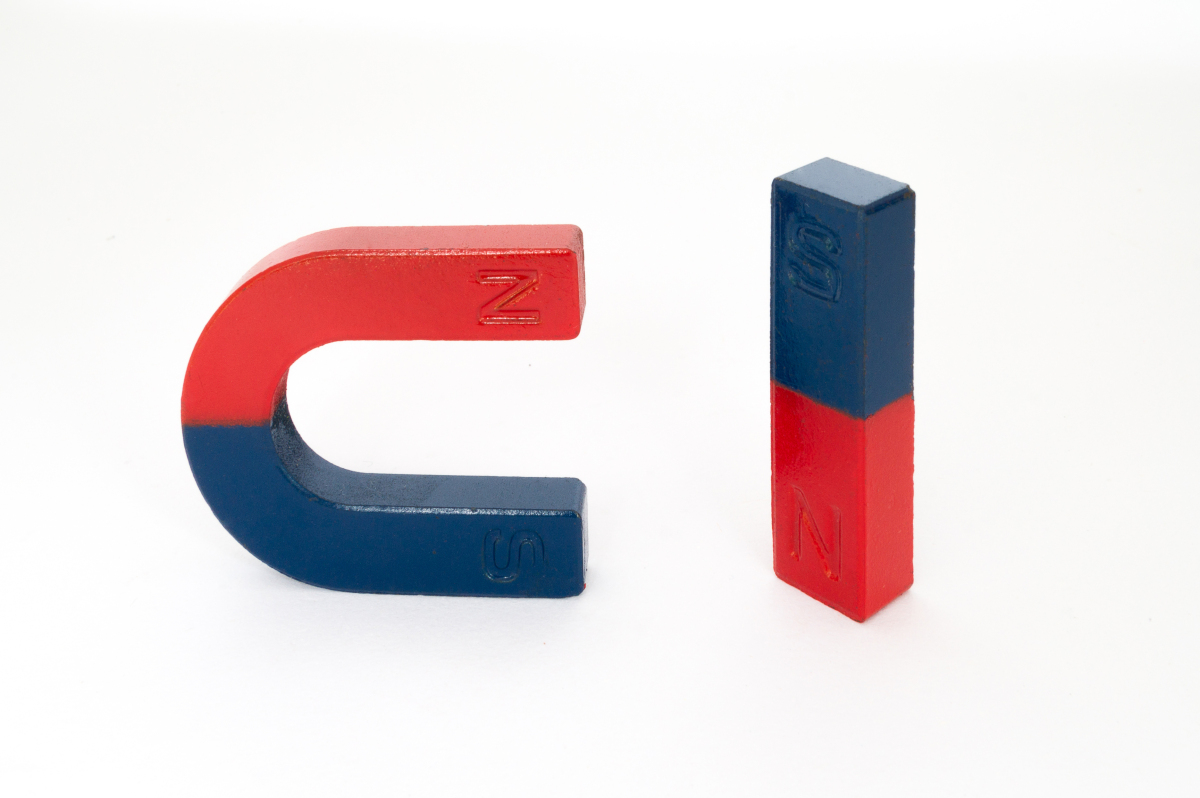
Objects, like permanent magnets, have an invisible magnetic field around them, and it is the interaction of this magnetic field with the magnetic field of another object that results in the attractive or repulsive forces we experience when working with magnets.
Types of Magnetism

A magnetic field results from an electric charge in motion. All matter that we interact with is made up of the three fundamental subatomic particles: electrons, neutrons, and protons. Neutrons and protons are packed tightly in an atom’s nucleus, and do not move about very much, so although protons have a positive electric charge, the magnetism that we experience in day to day life is not a result of protons in motion. Electrons however do move quite a bit. In the Rutherford-Bohr model of the atom, electrons move around the nucleus in circular orbits much like planets orbit the Sun. It is the motion of these electrons that results in a magnetic field.
If all matter is made up of electrons, neutrons and protons, then why don’t all materials exhibit magnetism? In fact, all materials do exhibit some magnetic properties, but some of these properties are different from our common experience with magnetism.

Paramagnetism is a magnetic property exhibited by materials such as aluminum and oxygen that interact weakly with magnetic fields. They are attracted to magnets, but cannot maintain their own magnetic field so they cannot be used to create a permanent magnet.

Domain Theory
The motion of charges in ferromagnetic materials can cause each of the atoms in the material to behave like a tiny magnet, with a north pole and a south pole. These tiny magnets naturally align themselves in small pockets of the material, called domains, so that the north pole of one atom is pointing toward the south pole of a nearby atom. This arrangement extends through the entire domain, so that all of the north poles are oriented in the same direction. This turns the domain into a tiny permanent magnet with a north pole and a south pole. Within the material, the north poles and south poles of the various domains may be either:
- Ordered, with the north pole of each domain oriented in the same direction as virtually all of the rest. This is the result of an external magnetic field, inducing all of the domains to align their magnetic fields with the external magnetic field. If the external field is removed and the domains maintain their alignment, the object is now a permanent magnet. Although known as a permanent magnet, the domains will eventually revert to a less ordered state over time.
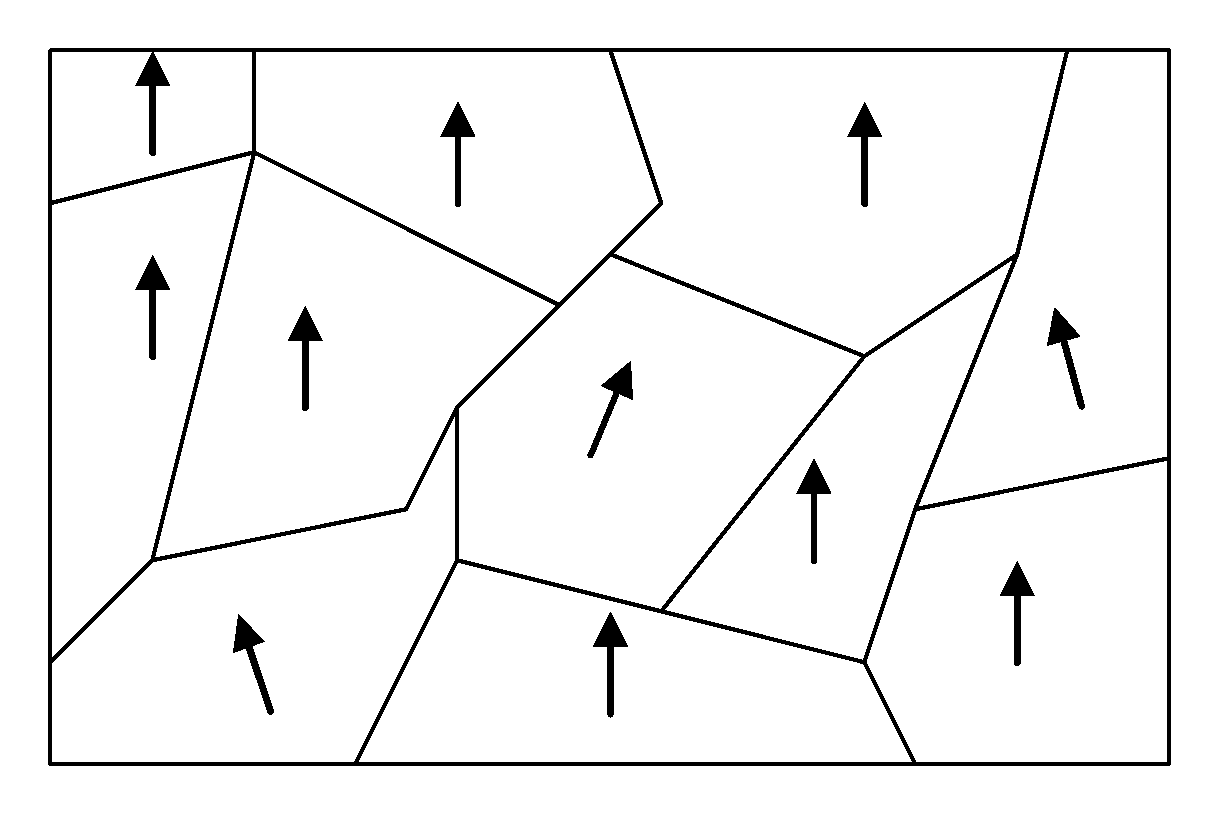
- Disordered, with no apparent pattern to the orientation of each domain’s magnetic field with respect to any other.
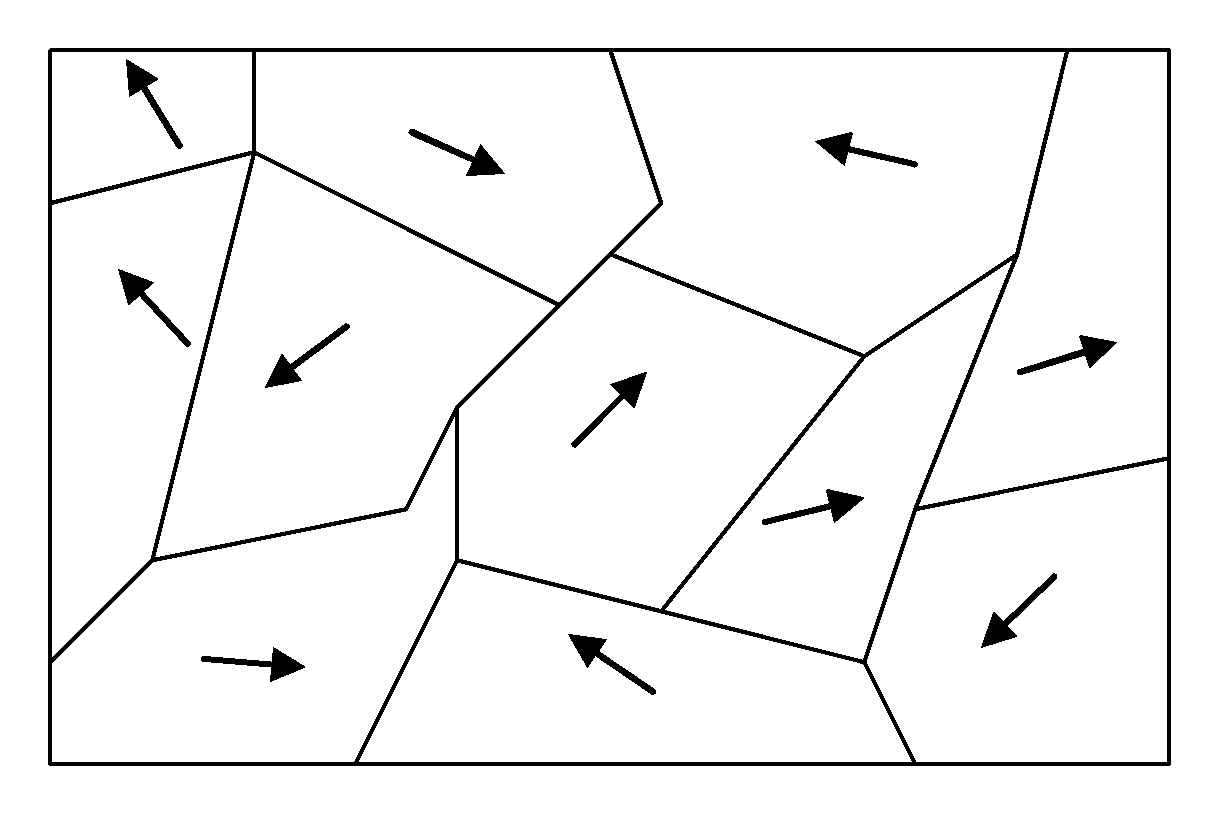
- Semi-ordered, in between the ordered and disordered states. This can be the case if the external magnetic field is not very strong, or, if a permanent magnet is reverting back to a disordered state. This process can be accelerated by heating the material or subjecting it to physical stress such as vibration.
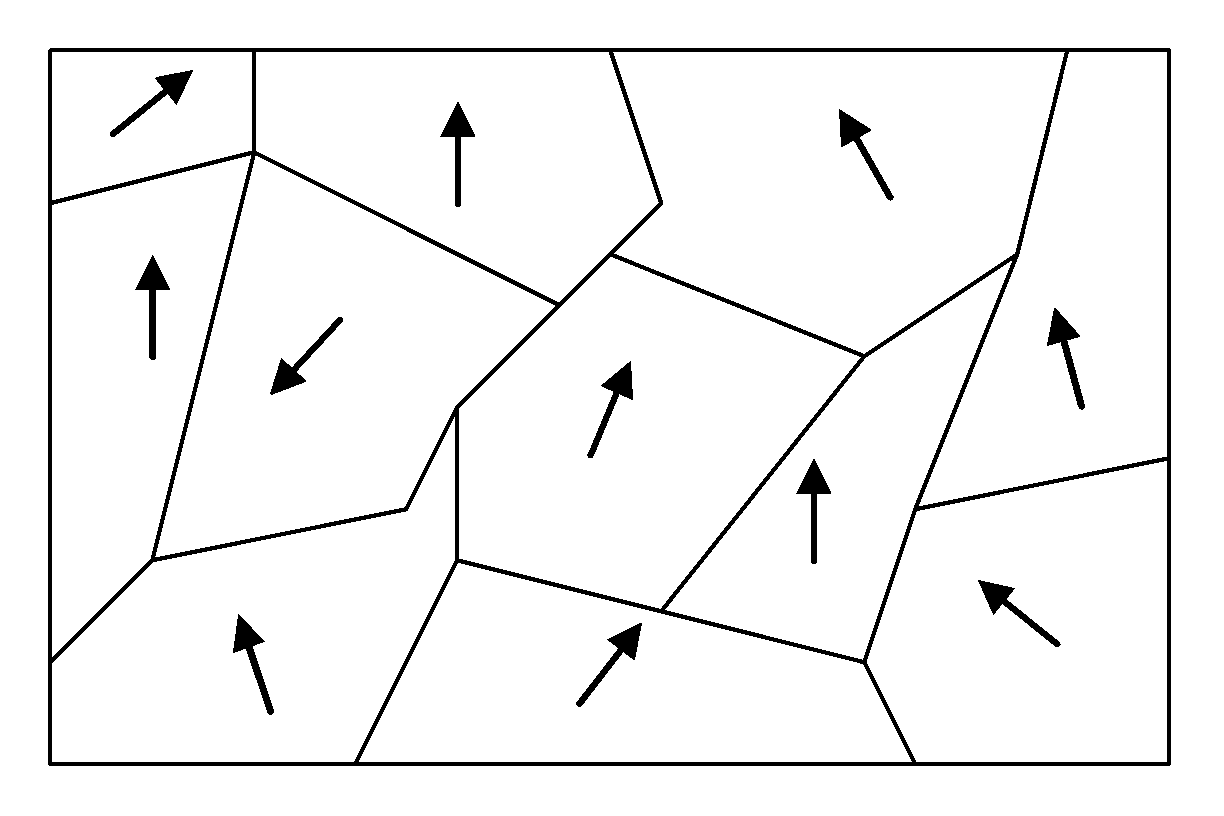
Magnetic Field Lines
The arrows indicating the direction of each domain’s magnetic field can be extended to form magnetic field lines which can be used to visualize the strength and direction of the magnetic field within and around an object.
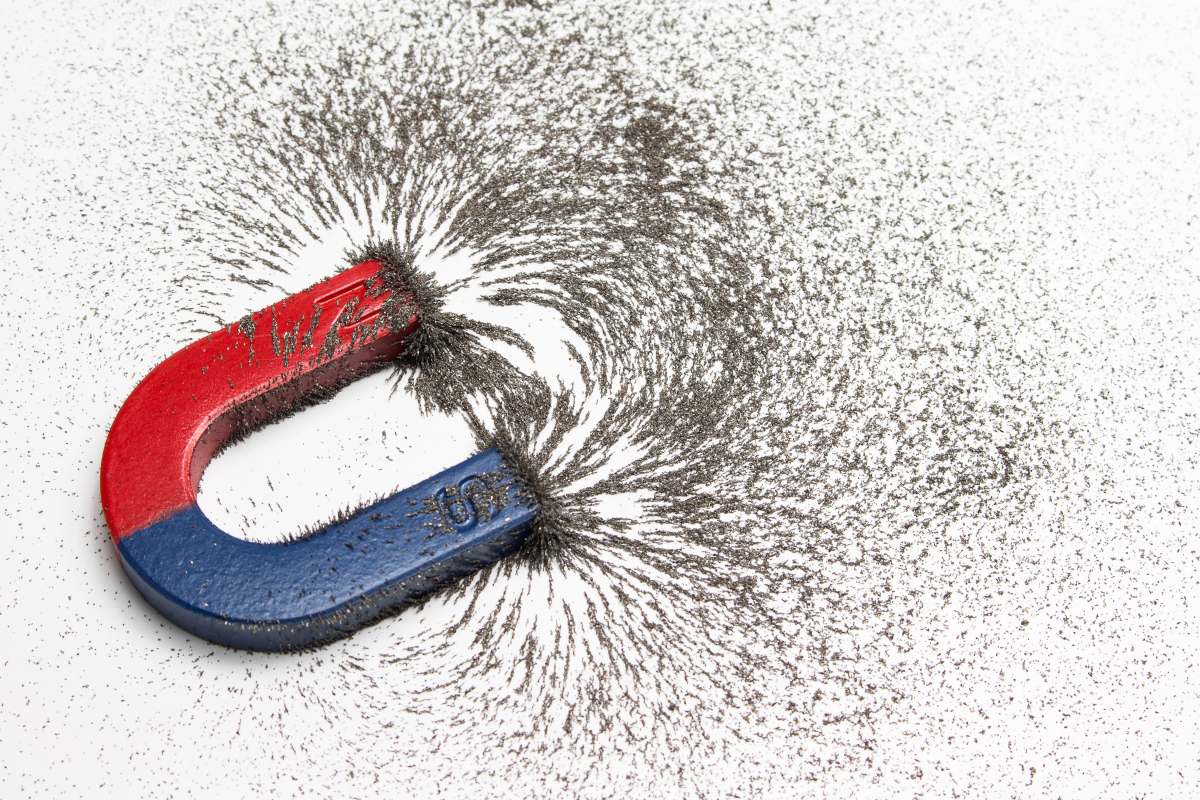
By convention, magnetic field lines include arrows to indicate the direction the north pole of a compass needle would point at a particular point in the field. In a bar magnet, the magnetic field lines within it might look like the following:
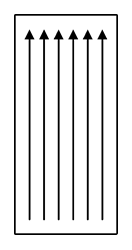
But since a magnetic field extends into the space surrounding an object as well, the magnetic field lines need to be extended to form complete loops. These loops cut through a magnet from its south pole to its north pole, then continue into the space surrounding the magnet exiting from its north pole and entering at its south pole.

Oersted’s Principle

This is easier to remember by applying the “right hand rule” where your thumb represents the direction of current flow and your fingers encircling the conductor represent the direction of the magnetic field.
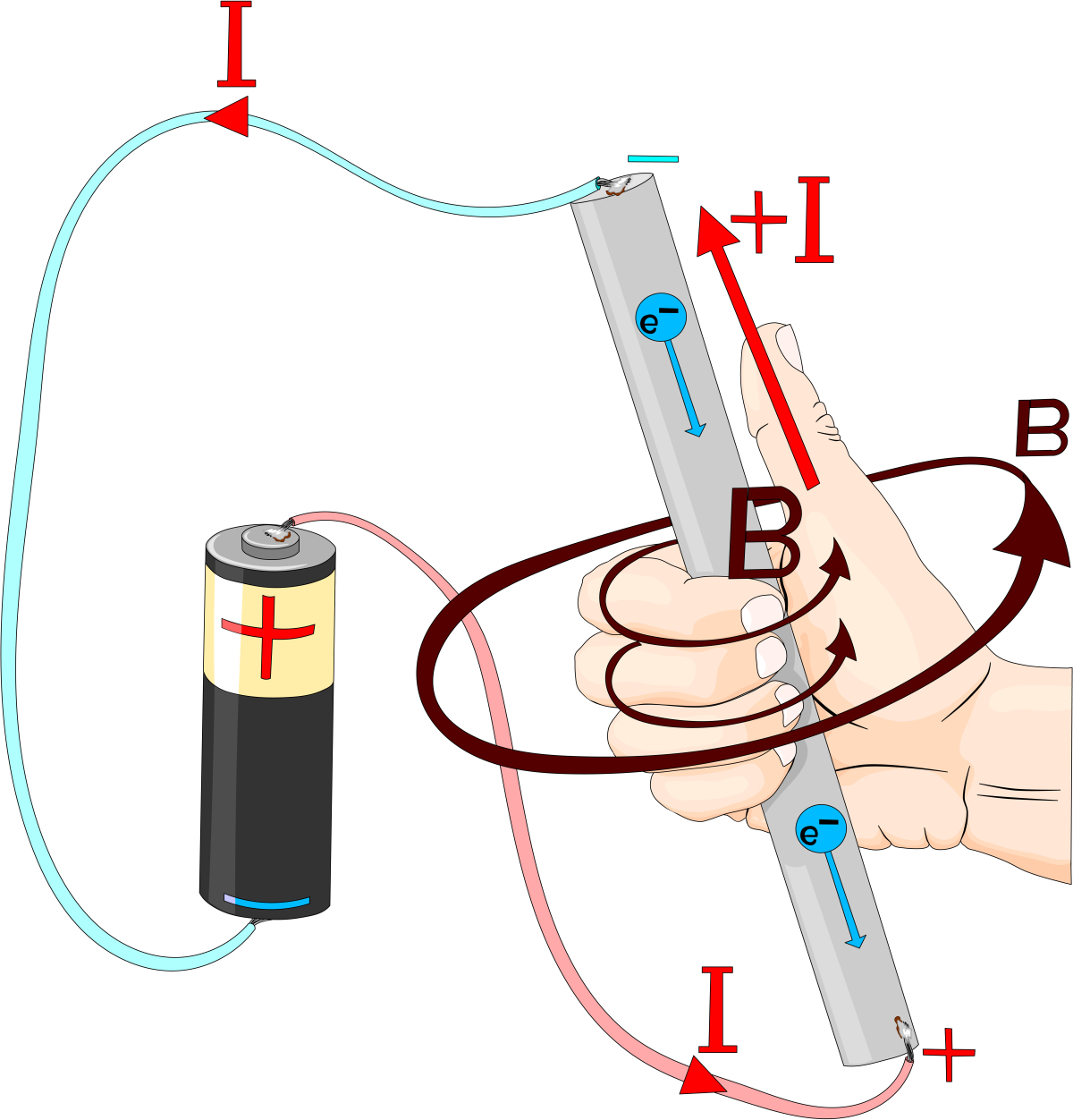
Solenoids
A solenoid is a coil of wire that can create a magnetic field by passing an electric current through it. This field can be strengthened if the wire is wrapped around a ferromagnetic core.

The direction of the resulting magnetic field lines through the core of the solenoid can also be remembered using a right hand rule. For this right hand rule, you wrap your fingers in the direction of the current flow through the solenoid’s coils. Your thumb will point in the direction of the magnetic field lines, i.e., to the north pole of the solenoid.
The Motor Principle
The motor principle tells us that a current carrying conductor in an external magnetic field will experience a force perpendicular to both the direction of current flow and the direction of the magnetic field.
Fleming’s Left Hand Rule
The motor principle tells us that the force on a current carrying conductor will be perpendicular to both the direction of current flow and the direction of the magnetic field, but, this leaves two possible directions that the force may be applied. For example, if the current flow was [S], and the direction of the magnetic field was [E], the direction of the force on the conductor could be either [up] or [down], as both of these directions are perpendicular to both [S] and [E].
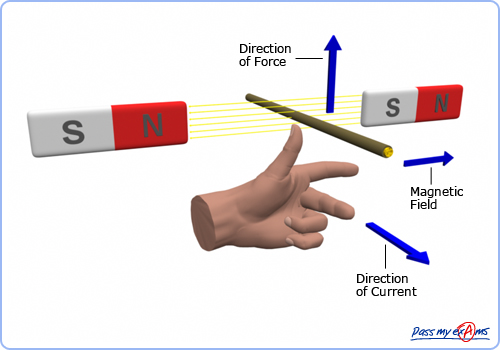
John Ambrose Fleming noted that the direction of a force on a current carrying conductor in an external magnetic field was always predictable, and created the left hand rule as an easy way to remember the direction of the force. Fleming’s left hand rule can be applied by manipulating your left hand so that your thumb, index finger, and middle finger are perpendicular to each other as shown in the diagram. You align your index finger with the magnetic field, and your middle finger with the electric current flow. Your thumb will then point in the direction of the force on the conductor.
Right Hand Rule for Motors
If you were to research the left and right hand rules, you would find that there are many variations that exist. Fleming also created a right hand rule that applies to generators; in our course we are only concerned with his left hand rule as it applies to motors. There are also variations of Fleming’s left hand rule, that use the right hand instead, using different digits to represent the magnetic field, current flow, and resulting force. These variations just provide different ways to remember the same relation that Fleming’s original left hand rule represents.

A common right hand rule for motors uses the right hand, with all fingers outstretched and the thumb at right angles to the fingers. In this right hand rule, the outstretched fingers represent the direction of the magnetic field and the thumb represents the direction of current flow, just like the right hand rule for a straight conductor, which can make this rule easier to remember than Fleming’s original left hand rule. The electromagnetic force on a conductor in a magnetic field will be in the direction that the palm would push on it.
 Impact of Electromagnetic Technology
Impact of Electromagnetic Technology
Many electromagnetic technologies have been developed for the benefit of society and the environment. From mine sweeping technologies to wind turbines to medical imaging devices, electromagnetic technologies improve outcomes for individuals and other organisms in the environment. For this learning task, you will conduct research to evaluate the impact of an electromagnetic technology that is used for the benefit of society or the environment and share your findings with your classmates. You should:
- Conduct research about a specific electromagnetic technology.
- Provide a description of the electromagnetic technology.
- Provide specific examples of positive impacts the electromagnetic technology has had on people and/or the environment.
- Explain your reasoning for the selection of each positive impact.
Components of a DC Motor
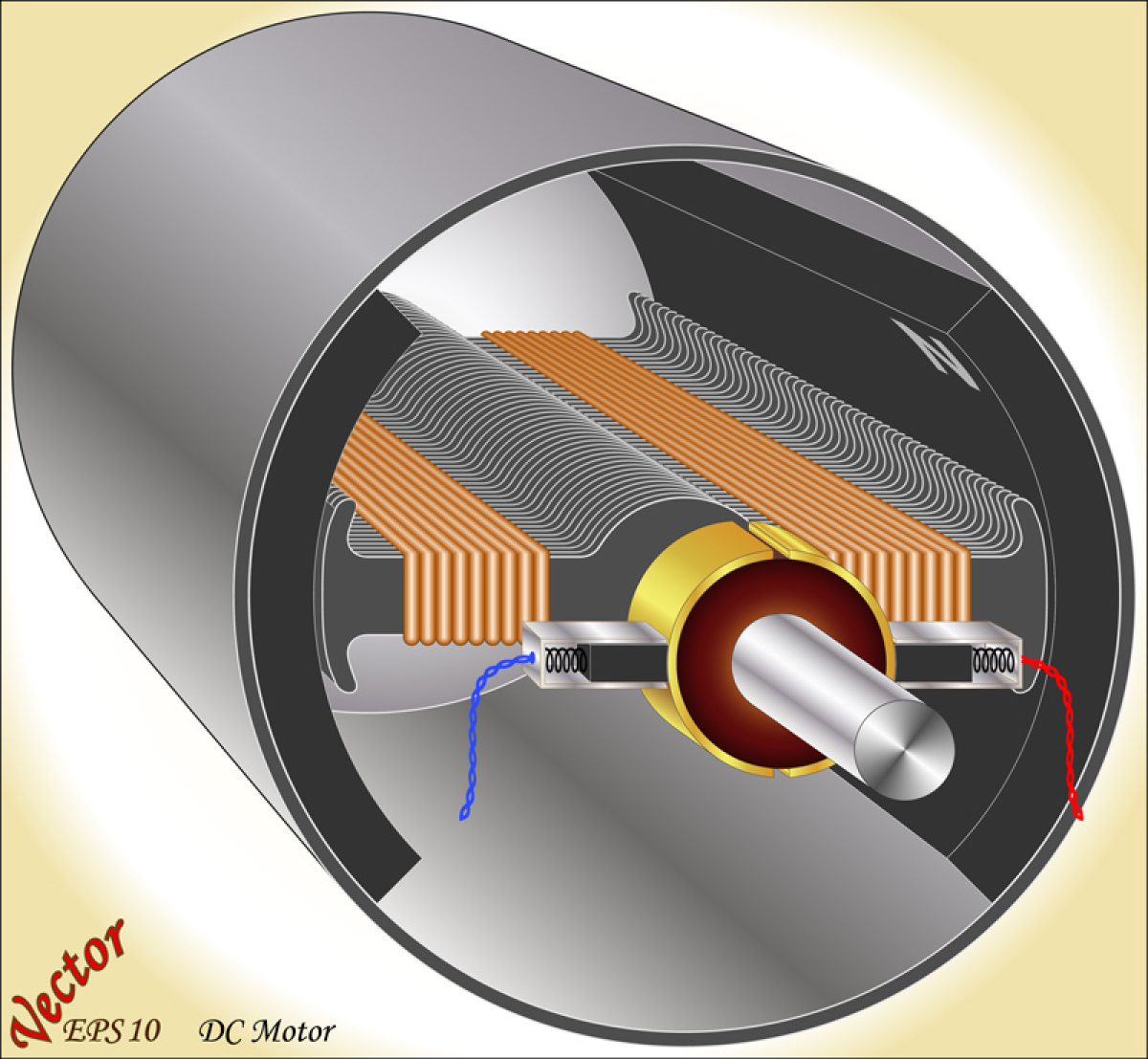
The stator also includes brushes. The purpose of the brushes is to transfer electrical energy to the commutator.
The rotor is the rotating part of a DC motor. In most motors, it includes the armature, commutator, and a shaft to transmit mechanical energy out.
The armature is the energy converting part of the motor. It is almost always constructed of coil of wire and its job is to convert electric energy into mechanical energy.
The commutator is part of the rotor, and its purpose is to supply the electrical energy from the brushes to the armature. In a DC motor, the commutator switches the direction of current through the armature as the rotor rotates, to ensure the rotor keeps rotating. If the current flow through the armature was always in the same direction, the armature would align itself so that the north pole of the magnetic field it generated was as close as possible to the south pole of the field coils or magnets (the same applies to the south pole of the armature and north pole of the field coils or magnets), and the rotor would be stuck in that position. The commutator is usually a ring that is broken in two locations – each half of the ring is connected to one end of the armature coil. Because of this structure, the commutator in a DC motor is sometimes referred to as a split ring commutator. When the rotor rotates far enough, the brushes break contact with the halves of the commutator they were in contact with, and make contact with the other halves, reversing the flow of current in the armature coil.
CONSOLIDATION
Summary:
The law of magnetic poles states that like magnetic poles repel each other while unlike magnetic poles are attracted to each other.
Ferromagnetism is exhibited by materials such as iron, nickel, and cobalt that interact strongly with magnetic fields.
Paramagnetism is exhibited by materials such as aluminum and oxygen that interact weakly with magnetic fields.
Diamagnetism is a property of all materials that causes a material to be repelled by a magnetic field.
Domain theory says that within a ferromagnetic material, small pockets are formed within which the magnetic dipoles of most of the atoms are aligned in the same way. If the dipoles of most domains within a material are aligned, the material will produce a magnetic field. Over time, the domains have a natural tendency to shift out of their state of being mostly aligned.
Magnetic field lines are used to indicate the direction that a compass needle would point north, and provide a means to visualize the magnetic field within and around an object.
The right hand rule for straight conductors says that if we point our thumb in the direction of the current flow, our fingers will wrap around the wire showing the direction of the magnetic field lines.
The right hand rule for solenoids says that if we wrap our fingers around the solenoid in the direction of current flow, our thumb will point to the north pole of the solenoid.
The motor principle tells us that a current carrying conductor in an external magnetic field will experience a force perpendicular to both the direction of current flow and the direction of the magnetic field. Fleming’s left hand rule and the right hand rule for motors provide an easy ways to remember what the direction of the force on the conductor will be.